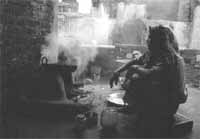What s cooking?
 the energy crisis that raised its fearsome head in the 1970s is not really over yet. Threatening to bring the industrial world to a grinding halt, it finds new guises to sustain itself. The two billion people across the globe for whom clean, safe and cheap fuel remains inaccessible can vouch for it. They suffer because supplying fuel at affordable prices to the masses still remains an ambitious dream. While the urban population can always choose from various fuel, the same does not hold true for the rural communities, who use twigs, wood splinters and cow dung to fire their ovens. But these crude ovens and the cruder fuel they use come with attendant problems, the biggest being pollution and health implications.
the energy crisis that raised its fearsome head in the 1970s is not really over yet. Threatening to bring the industrial world to a grinding halt, it finds new guises to sustain itself. The two billion people across the globe for whom clean, safe and cheap fuel remains inaccessible can vouch for it. They suffer because supplying fuel at affordable prices to the masses still remains an ambitious dream. While the urban population can always choose from various fuel, the same does not hold true for the rural communities, who use twigs, wood splinters and cow dung to fire their ovens. But these crude ovens and the cruder fuel they use come with attendant problems, the biggest being pollution and health implications.
Scientists seeking to bring relief to the masses have done considerable work on developing cleaner, cheaper alternatives. Methanol, also known as wood alcohol, has emerged as one such alternative, being cleaner and more efficient than most fossil fuels. It can be manufactured either on a large-scale, using natural gas as the source, or from biomass wastes from certain industries like pith (coir) from coconut husk, wood pieces and pith bagasse from the sugar industry. For years, rural communities have made methanol by wood distillation. Now efforts are on to produce it on a large scale from natural gas.
Methanol is economically viable, says Bengt S
Related Content
- Tracking SDG7: the energy progress report 2021
- What's cooking: digital transformation of the agrifood system
- Energy Safety Nets:Using social assistance mechanisms to close affordbility gaps for the poor
- Energizing finance: taking the pulse 2019
- Union Budget 2019-2020
- The contribution of household fuels to ambient air pollution in India: a comparison of recent estimates
